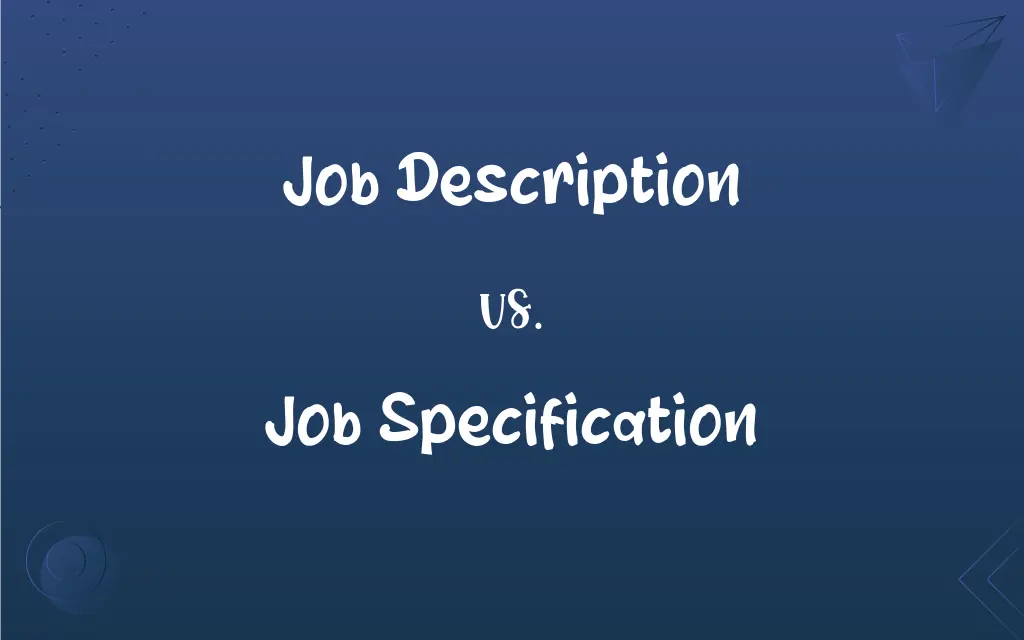Job Description vs. Job Specification: What's the Difference?
Edited by Janet White || By Harlon Moss || Updated on October 5, 2023
A Job Description outlines the tasks and responsibilities of a role, while a Job Specification details the qualifications and attributes a candidate should possess.

Key Differences
The Job Description and Job Specification, while interconnected, serve two distinct purposes in the recruitment and hiring process. A Job Description is primarily concerned with the role itself. It offers a clear and concise overview of the duties, responsibilities, and tasks that the job entails. This description acts as a guidepost, letting prospective candidates know what will be expected of them in the role.
Job Specification, on the other hand, shifts focus from the role to the individual who will fill that role. This document lays out the qualifications, skills, education, experience, and other attributes that an ideal candidate should possess. It acts as a benchmark for assessing and screening potential candidates for suitability.
In essence, while the Job Description outlines the 'what' of a position, the Job Specification deals with the 'who'. A hiring manager uses the Job Description to detail what the job involves and what deliverables or outcomes are expected. Simultaneously, they utilize the Job Specification to ensure they find the best fit - someone who has the right mix of skills, experience, and temperament.
Furthermore, both these documents are critical for performance assessments and evaluations once a candidate is onboarded. The Job Description offers a foundation for setting targets and expectations, while the Job Specification can guide professional development and training, ensuring the employee possesses the necessary skills and attributes for success.
It's also worth noting that, in some organizations, these two documents might be combined into a single document. Regardless of the format, both the description of the role and the qualifications required remain pivotal in the hiring and management process.
ADVERTISEMENT
Comparison Chart
Primary Focus
Tasks, duties, and responsibilities of the role
Qualifications and attributes of the candidate
Used For
Describing the role
Describing the ideal candidate
Content
Roles, responsibilities, and outcomes
Skills, experience, education, and other qualifications
Importance in Recruitment
Informs candidates about the role
Assists in candidate screening and selection
Post-Hiring Utility
Performance assessment and target setting
Training and professional development
ADVERTISEMENT
Job Description and Job Specification Definitions
Job Description
A document that clarifies the tasks and expectations for a role.
Candidates referred to the Job Description to understand their daily duties.
Job Specification
A guide to the traits and qualifications essential for job success.
Certifications in project management were on the Job Specification for the coordinator role.
Job Description
A written record of the functions and requirements of a specific job.
The Job Description made it clear that data analysis was a key component.
Job Specification
A document describing the ideal candidate's characteristics.
According to the Job Specification, prior leadership experience was preferred.
Job Description
A guide detailing the scope and objectives of a role.
The Job Description highlighted client interaction as a primary responsibility.
Job Specification
An outline of what an organization seeks in a potential employee.
The Job Specification noted that proficiency in Spanish would be a bonus.
Job Description
A detailed outline of the roles and responsibilities tied to a position.
The Job Description for the manager detailed team leadership and strategy planning.
Job Specification
A breakdown of the qualifications and attributes ideal for a role.
The Job Specification listed a master's degree as a requirement.
Job Description
An overview of what a particular position entails in an organization.
According to the Job Description, the engineer would work closely with the design team.
Job Specification
A summary of the skills, education, and experience required for a job.
The Job Specification emphasized strong communication skills.
FAQs
What might you find in a Job Description?
A Job Description lists duties, responsibilities, and outcomes of the role.
How does a Job Specification assist in recruitment?
A Job Specification details the qualifications and attributes, aiding in candidate screening.
Can a Job Description and Job Specification be combined?
Yes, some organizations might merge them into a single document.
What does a Job Description primarily focus on?
A Job Description primarily outlines the tasks and responsibilities of a role.
What's the key content of a Job Specification?
It details skills, experience, education, and other qualifications.
Can a Job Description change over time?
Yes, as organizational needs evolve, the Job Description may be updated.
Do all organizations have separate Job Descriptions and Job Specifications?
No, the format varies; some may combine them or have alternative documents.
How does a Job Specification help with professional development?
It guides training by highlighting the necessary skills and attributes.
What happens if a candidate doesn't meet the Job Specification?
They might not be shortlisted, or alternative skills may be considered.
How often should a Job Description be reviewed?
Regularly, to ensure it aligns with current organizational needs and industry trends.
Who typically drafts the Job Specification?
Often HR, in collaboration with the department hiring, drafts the Job Specification.
How detailed should a Job Specification be?
It should be comprehensive enough to clearly define the ideal candidate's attributes.
Can a Job Specification include soft skills?
Absolutely, soft skills like communication or teamwork can be vital.
Why is a Job Description important for an employee?
It sets expectations and serves as a basis for performance assessments.
Is a Job Specification always strict in its criteria?
While some criteria are essential, others might be "preferred" or flexible.
Is it essential for a candidate to meet every point on a Job Specification?
Not always; some points are crucial, while others are bonuses or preferences.
Who benefits more from a Job Description, the employer or the employee?
Both; the employer communicates expectations, and the employee understands their role.
Why is it crucial to keep both the Job Description and Job Specification updated?
To ensure alignment with current needs and attract the right candidates.
Should employees be familiar with their Job Description post-hire?
Yes, as it guides their responsibilities and performance expectations.
Can a candidate refer to the Job Description during interviews?
Yes, it can guide them in understanding and discussing role expectations.
About Author
Written by
Harlon MossHarlon is a seasoned quality moderator and accomplished content writer for Difference Wiki. An alumnus of the prestigious University of California, he earned his degree in Computer Science. Leveraging his academic background, Harlon brings a meticulous and informed perspective to his work, ensuring content accuracy and excellence.
Edited by
Janet WhiteJanet White has been an esteemed writer and blogger for Difference Wiki. Holding a Master's degree in Science and Medical Journalism from the prestigious Boston University, she has consistently demonstrated her expertise and passion for her field. When she's not immersed in her work, Janet relishes her time exercising, delving into a good book, and cherishing moments with friends and family.































































